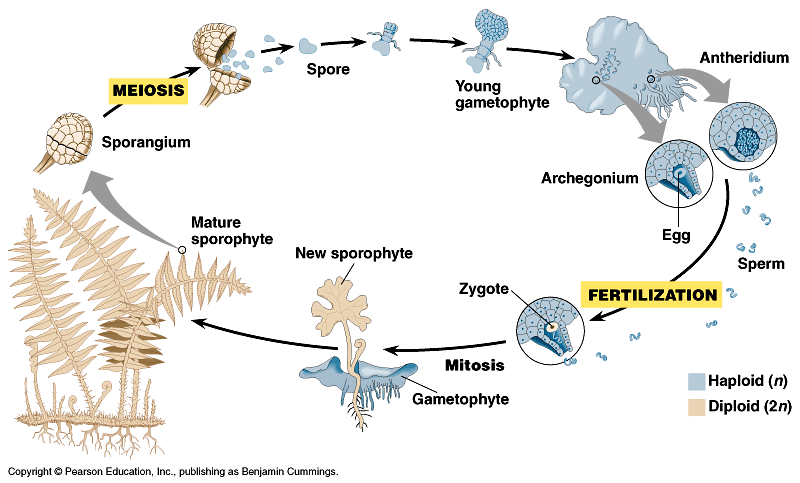PLANT BIOLOGY FOR NON-SCIENCE MAJORS
Department of Cell Biology & Molecular Genetics
![]()
Department of Cell Biology & Molecular Genetics
![]()
Algae and Spore forming plants
Plant Diversity: Evolution of
Life Cycles
I. Kingdom Protista: The
Algae
· Eukaryotic unicellular
and simple multicellular organisms
· photoautotrophs;
photosynthetic pigments – primarily chl a, b, and/or c. Also accessory
pigments.
· phytoplankton versus
seaweeds (the body of a seaweed is called a thallus; there are no roots,
stems, or leaves).
· requires a wet
or very moist environment to exist and reproduce (algae have motile male
gametes and single celled sex organs)
· Reproduction: asexually
or sexually (alternation of generations: haploid, gamete-producing generation
called the gametophyte and a diploid, spore-producing generation called
the sporophyte. Spores
released from the sporophyte develop into gametophytes).
Types of Algae:
A. Diatoms
1. unicellular; primarily asexual reproduction
2. are components of cold freshwater and marine phytoplankton: base of
the marine food chain
3. photosynthetic pigments: Chl a, c, carotenoids and xanthophylls.
The cell walls contain silica (glass)
4. Commercial uses: diatomaceous earth.
B. Red
Algae
1. multicellular seaweeds. All red algae reproduce sexually
2. warm, tropical, marine inhabitants; deep waters. Play a significant
role in coral reefs.
3. Chl a, carotenoids, phycoerythrin (a red accessory pigment)
4. Cell walls are cellulose, agar & carageenan. Coral reef red algae
have calcium carbonate and magnesium carbonate cell walls.
5. Commercial uses: various
C. Brown
algae
1. all are multicellular seaweeds and marine inhabitants of cool shallow
waters. Sexual and asexual reproduction.
2. Chl a, c, and the brown carotenoid pigment: fucoxanthin. Cell walls
made of cellulose and algin.
3. Fucus, Laminaria, and giant kelp (Macrocystis sp.)
4. Commercial uses: various
D. Dinoflagellates
1. phytoplankton: base of the marine food chain. Mainly unicellular;
mostly asexual reproduction
2. Chl a, Chl c, and a mix of carotenoids
3. generally a cellulose cell wall
4. red tides by explosive growth (called blooms) in warm coastal waters;
bioluminescent forms; and Pfiesteria
toxin
5. No commercial value
E. Green
algae
1. chloroplasts are very similar in structure & pigment composition
to chloroplasts in plants. Cellulose cell walls like plants.
2. predominantly freshwater, some marine
3. both sexual and asexual reproduction
4. many body forms: unicellular types, colonial forms, multicellular thallus
(‘leafy’) forms are seaweeds
5. can live in symbiosis with fungi = lichens
6. Commercial uses: various
II. The Plant Kingdom
A. Prior to 430 million
years ago, life only in oceans.
B. Characteristics land
plants share with their green algal ancestors
C. What are the challenges/adaptations
associated with life on land?
D. All land plants have
a sexual reproductive life cycle (alternation of generations):
1. haploid (1n) gametophyte and diploid (2n) sporophyte generations
2. sporophyte is larger and more noticeable than the gametophyte in all
land plants EXCEPT the Bryophytes.
E. Non-Vascular Land Plants
(Bryophytes)
1. Primitive Land Plants: Spore formers (mosses, liverworts, & hornworts).
Example: Marchantia, a liverwort you saw in lab
a) They dwell on land, but they have NO vascular system (rhizoids to anchor
only); they are restricted to wet environment; have pores on the thallus
surface, NOT stomata.
b) Life cycle: is water dependent reproduction (motile sperm swim to the
egg for fertilization).
c) 1n gametophyte has archegonium (female structures) and antheridium (male
structures).
d) 1n gametophyte spore is the dominant phase. 2n sporophytes are
only present for a short time after fertilization.
F. Vascular Land Plants
1. Ferns are seedless vascular plants. Better adapted to life on
land: leaves (called fronds) have true stomata.
2. Life cycle: is still water dependent (motile sperm swim to egg
for fertilization).
a) Reproductive structures are on the underside of the leaf; are sporangia
arranged in clusters called Sori.
(1) Meiosis in sporangium produces 1n spores (are homosporous). Spores
germinate to produce a ‘heart shaped’ 1n gametophyte.
(2) 1n gametophyte has archegonium (female structures) and antheridium
(male structures).
(3) Fertilized zygote (2n) in archegonium develops into a sporophyte.
The 2n sporophyte is larger and more dominant than 1n gametophyte.
There are NO seeds!
KNOW THE BASIC STEPS OF THE FERN LIFE CYCLE:

Classification of Plants:
# of Extant Species
I. Non vascular Land Plants
(Bryophytes):
Mosses
12, 000
Liverworts
6, 500
Hornworts
100
II. Vascular Land Plants:
A.
Seedless vascular plants:
Lycophytes
1, 000
Horsetails
15
Ferns
12, 000
B.
Advanced Vascular Seed Plants:
Gymnosperms:
Conifers
550
Cycads
100
Gingko
1
Gnetae
70
Angiosperms:
Flowering plants
250, 000
Additional sites of interest:
protists:
excellent pictures